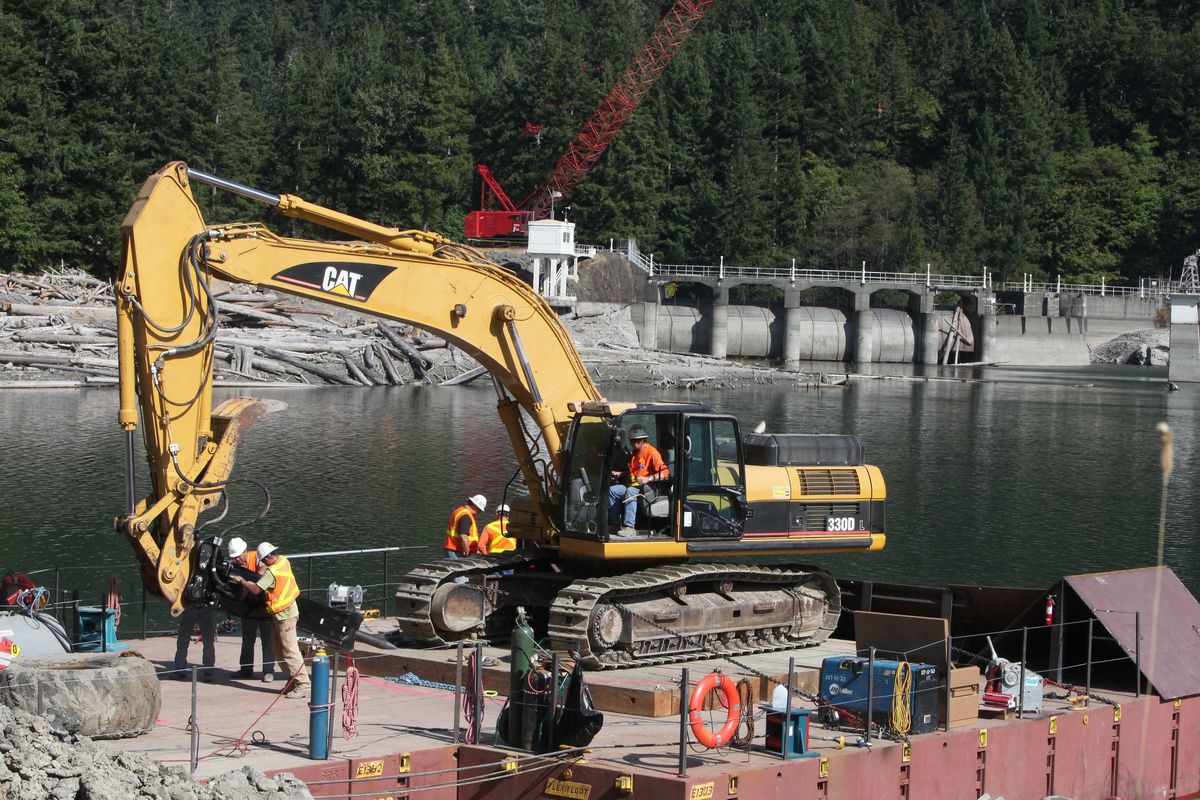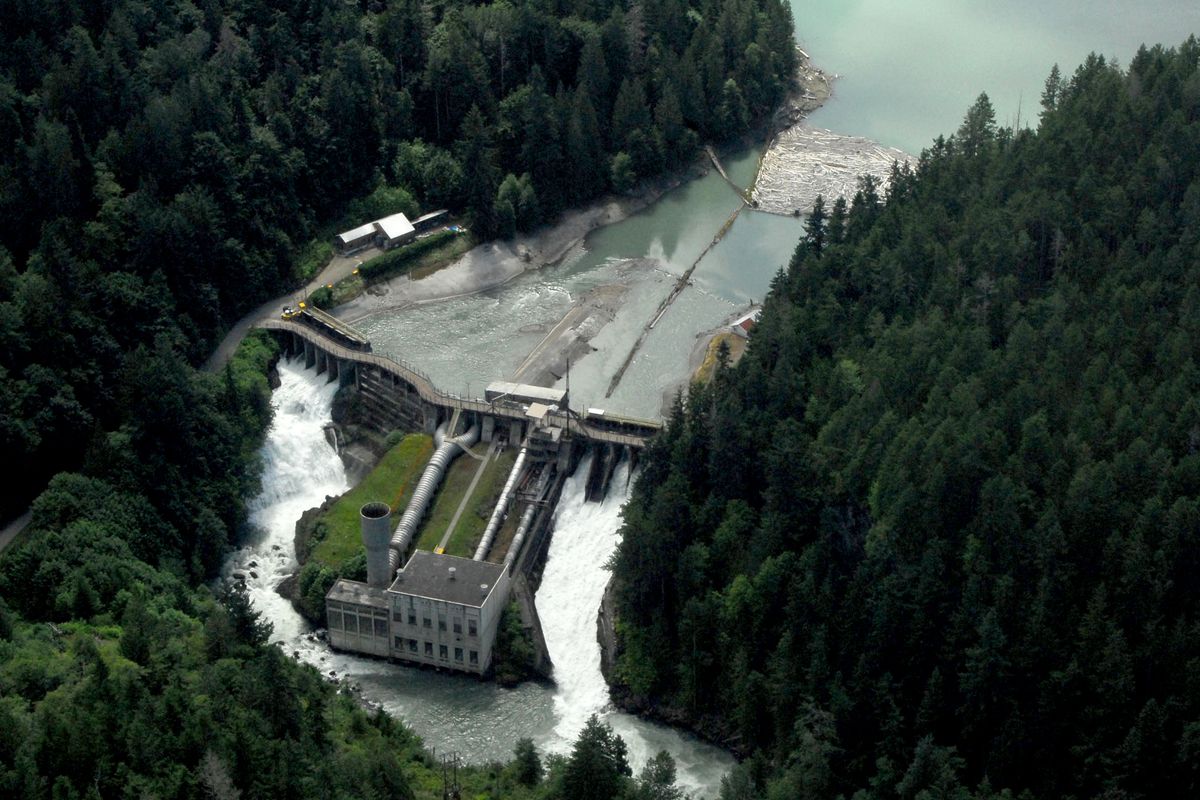Dams’ demise draws school of dignitaries, enthusiasts
A construction crew on Thursday prepares a hydraulic hammer on a barge that was towed to Glines Canyon Dam to start the demolition of the structure. The first chunks of the dam hit the water Thursday. (STEVE RINGMAN)
PORT ANGELES, Wash. – Unlike Eastern Washington, where talk of dam removal might be deemed fighting words, the removal of two dams on the Elwha River west of this port on the Juan de Fuca Strait are cause for celebration.
A two-day science symposium at the local college. Art exhibits. Concerts. A film festival. Sunset cruises on the bay. A banquet sponsored by the Lower Elwha Klallam tribe. Decks of playing cards that say “It’s a Big Dam Deal” on the back.
Celebrate Elwha, as the festivities are called, lead up to the ceremonial removal this morning of the first pieces of concrete from the 99-year-old Elwha Dam and the 84-year-old Glines Canyon Dam.
When the project is completed in an estimated three years, the 108-foot Elwha and 210-foot Glines will be the biggest dams ever removed in the United States.
As U.S. Interior Secretary Ken Salazar joins members of the state’s congressional delegation, Gov. Chris Gregoire and local dignitaries at the base of the Elwha dam, people are expected to watch and cheer the ceremony on big-screen television monitors on the Port Angeles city pier, in nearby Sequim and across the Puget Sound in Seattle. It will also be webcast live.
“This is a particularly celebratory time,” Cathy Lear, a wildlife biologist for Clallam County, said Friday during a break from the symposium on river restoration.
For some scientists, it is the start of a unique opportunity to study how and if a river can be restored after a major dam comes out. For members of the environmental community, it represents decades of lobbying. For the tribe, it’s a dream that crosses generations.
“My mom remembers, when she was a little girl, they had meetings at the church about removing the dams,” said Brenda Frances, a spokeswoman for the tribe.
The tribe’s opposition actually pre-dates Elwha Dam. Both were built to supply power to Olympic Peninsula homes, businesses, mills and shipyards. But they were built without fish ladders, even though the law required them, and they destroyed much of the salmon habitat, and flooded some burial areas and other sacred sites. Tribal members protested, showing up at the site when construction began, but no one would listen, Tribal Chairwoman Frances Charles said.
“It was challenging in those days because we weren’t U.S. citizens,” Charles said.
For much of the 20th century, that was a lonely fight. But when the Glines Canyon Dam came up for relicensing in the 1970s – the Elwha was never licensed, so it didn’t have to be relicensed – the tribe, environmentalists and some fishing interests had an opening. Slowly they gathered support from federal agencies, which control much of the park and forest lands where the dams and river are located, from local businesses and utilities, and elected officials.
For a while, it split the community. Opponents of dam removal would boycott the businesses of supporters, and vice versa, Charles said. Tribal children in school were taunted by children whose parents wanted to preserve the dams.
“We had to intervene at the time, meet with the superintendent and sometimes the parents,” Charles said.
In 1992, Congress authorized the dams’ removal if that was needed to restore the river system – although not the money to pay for it. That came years later.
Meanwhile, scientists began compiling a wealth of data on the current state of the river and its environs that could serve as a baseline for changes when the dams come out.
Jeffrey Duda, a research ecologist with the U.S. Geological Survey’s Western Fisheries Research Center, said the dams’ removal will create a “living laboratory” for restoring a river. About 83 percent of the watershed is a protected wilderness, which helps control any outside influences to the river.
The goal is to get unbiased scientific data, with no value judgments, on the controversial topic of dam removal.
“This information will be going to decision-makers on the pros and cons, so they can weigh the costs of any future dam removal,” Duda said.
Not everyone agrees. Northwest River Partners, a Portland-based group that opposes efforts to breach the Snake River dams, says what happens on the Elwha can’t be extrapolated onto those Inland Northwest structures. Elwha and Glines are far older, less efficient, lack fish passages and don’t provide a vital waterway to the Pacific, Terry Flores, the group’s executive director, noted this week.
“There simply is no comparison,” Flores said.
Removal requires more than dynamiting the concrete dams. The water needs to be channeled, and tons of sediment settled behind the dams must be removed. The powerhouses must be removed. When the Elwha is running free again, no one knows for sure how long it will take for the salmon to return to the upper reaches of the river.
Based on Washington’s other “living laboratory,” the blasted areas surrounding Mount St. Helens that have been closely monitored since the 1980 eruption, the tribe and some scientists hope the fish can be re-established in five years. Tribal members are giving up their fishing rights in the river for five years to help in the restoration.
Mount St. Helens is about as good an analogy as any that exists, said Martin Doyle, a Duke University professor of river science and policy who spoke at the symposium Friday. But no one really knows, because so far only small dams have been removed in the United States.
“This is big, it’s just different,” Doyle said.
Because of that, those who support dam breaching and those who oppose it have Elwha restoration under a microscope, to see how well it works and how much it costs.
There are some 80,000 dams in the United States, and many will face challenges when their licenses come up for renewal. Weighing the costs and benefits of dam removal should become a key element for any discussion of future dam removals, Doyle said.

